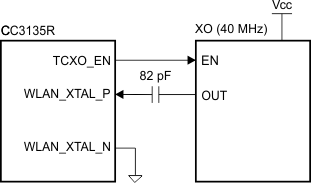SWAS037B February 2019 – May 2021 CC3135
PRODUCTION DATA
- 1 Features
- 2 Applications
- 3 Description
- 4 Functional Block Diagram
- 5 Revision History
- 6 Device Comparison
- 7 Terminal Configuration and Functions
-
8 Specifications
- 8.1 Absolute Maximum Ratings
- 8.2 ESD Ratings
- 8.3 Power-On Hours (POH)
- 8.4 Recommended Operating Conditions
- 8.5 Current Consumption Summary: 2.4 GHz RF Band
- 8.6 Current Consumption Summary: 5 GHz RF Band
- 8.7 TX Power Control for 2.4 GHz Band
- 8.8 TX Power Control for 5 GHz
- 8.9 Brownout and Blackout Conditions
- 8.10 Electrical Characteristics for DIO Pins
- 8.11 Electrical Characteristics for Pin Internal Pullup and Pulldown
- 8.12 WLAN Receiver Characteristics
- 8.13 WLAN Transmitter Characteristics
- 8.14 WLAN Transmitter Out-of-Band Emissions
- 8.15 BLE/2.4 GHz Radio Coexistence and WLAN Coexistence Requirements
- 8.16 Thermal Resistance Characteristics for RGK Package
- 8.17 Timing and Switching Characteristics
- 8.18 External Interfaces
- 9 Detailed Description
- 10Applications, Implementation, and Layout
- 11Device and Documentation Support
- 12Mechanical, Packaging, and Orderable Information
Package Options
Mechanical Data (Package|Pins)
- RGK|64
Thermal pad, mechanical data (Package|Pins)
- RGK|64
Orderable Information
8.17.5.4 Fast Clock (Fref) Using an External Oscillator
The CC3135 device can accept an external TCXO/XO for the 40-MHz clock. In this mode of operation, the clock is connected to WLAN_XTAL_P (pin 23). WLAN_XTAL_N (pin 22) is connected to GND. The external TCXO/XO can be enabled by TCXO_EN (pin 21) from the device to optimize the power consumption of the system.
If the TCXO does not have an enable input, an external LDO with an enable function can be used. Using the LDO improves noise on the TCXO power supply.
Figure 8-12 shows the connection.
 Figure 8-12 External TCXO Input
Figure 8-12 External TCXO Input
Table 8-17 lists the external Fref clock requirements.